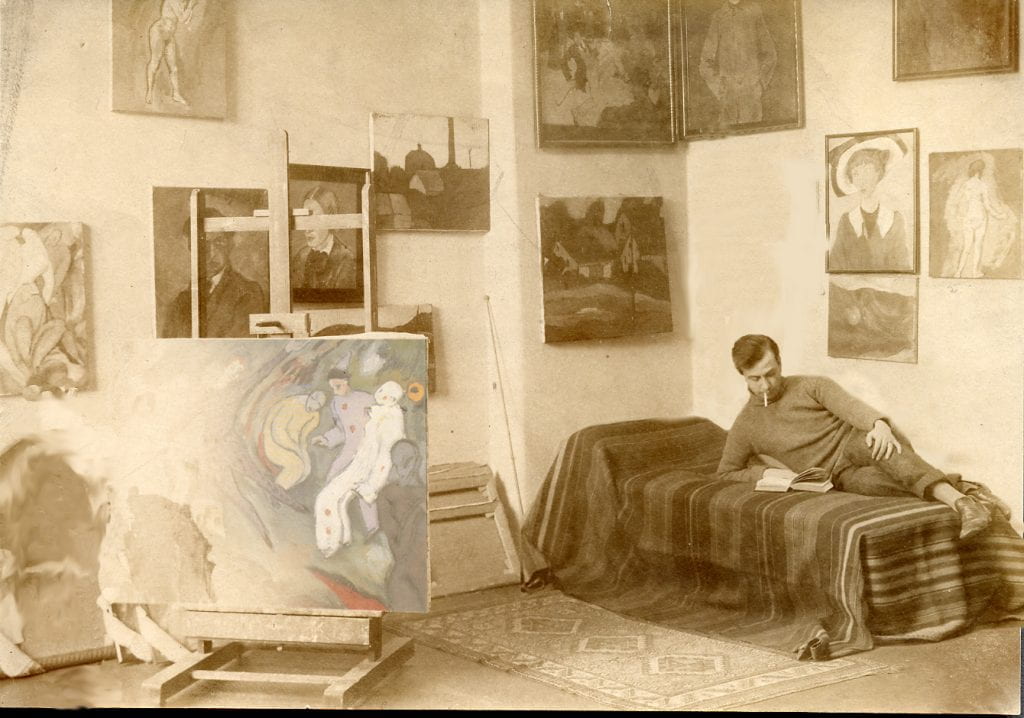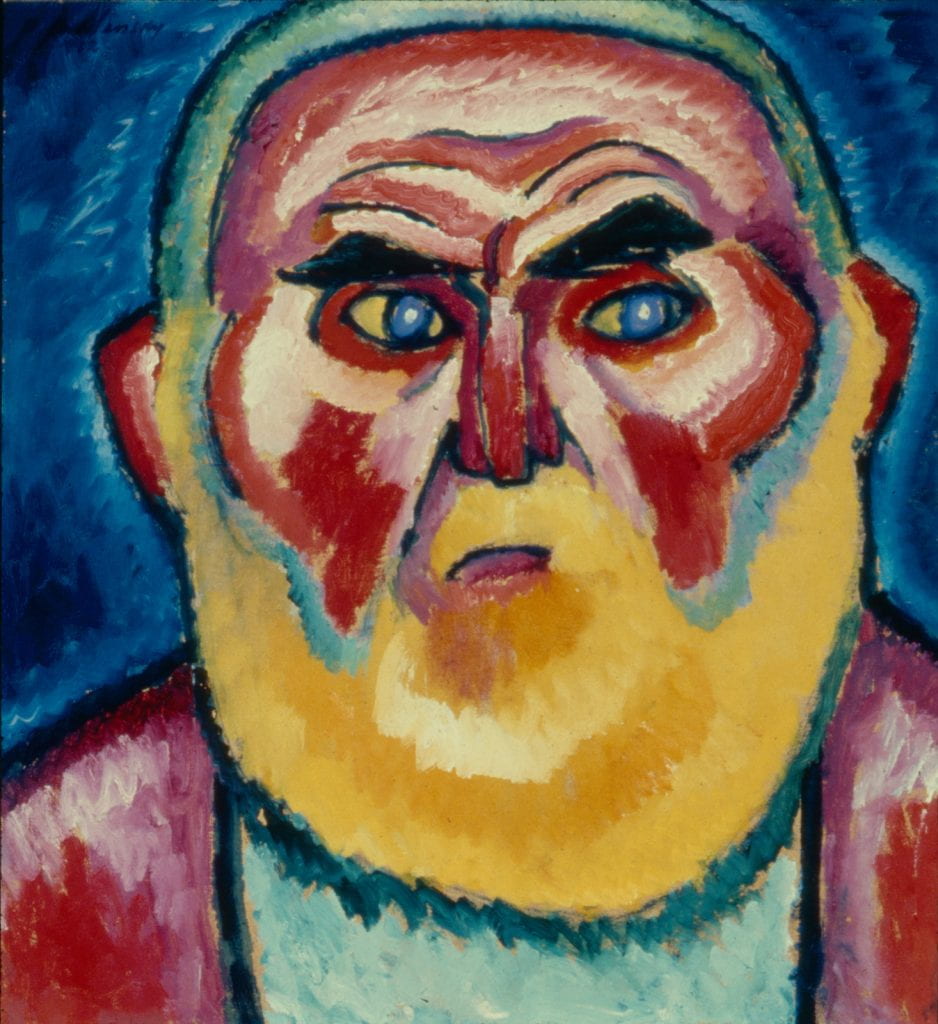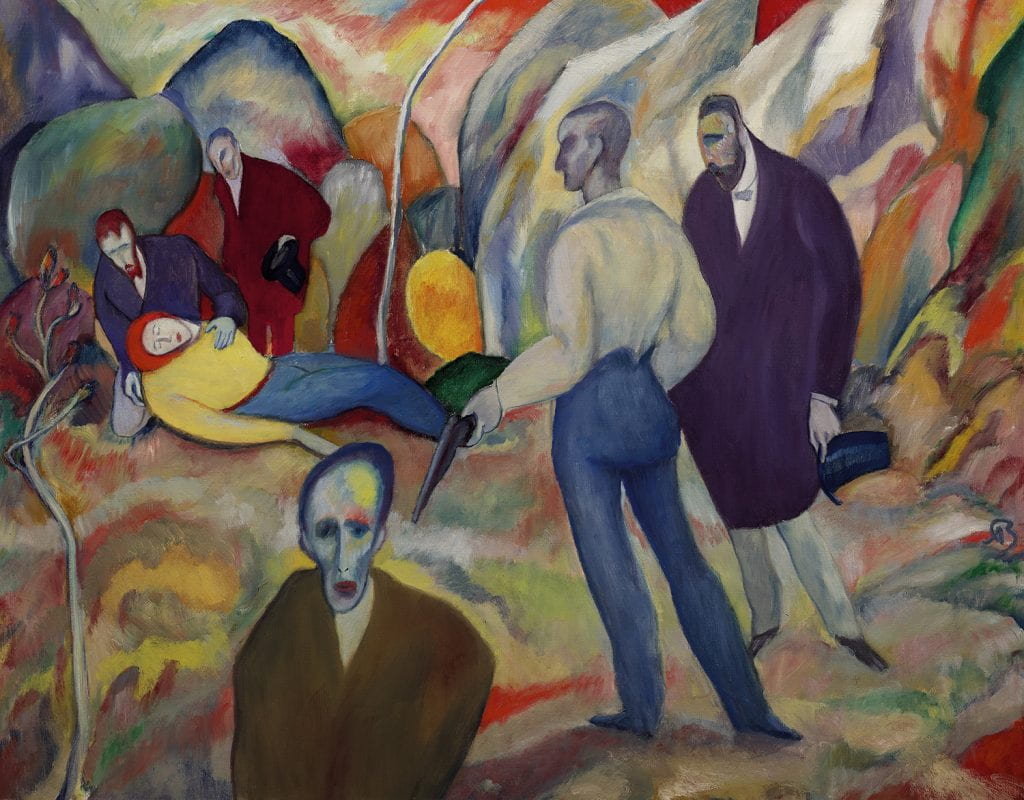
Guest post by Jenny McComas.
The inaugural exhibition of Der Blaue Reiter at Munich’s Galerie Thannhauser in December 1911 helped catapult avant-garde artists such as Wassily Kandinsky and Franz Marc to international fame. Although often described as German Expressionists, the artists of the Munich-based Der Blaue Reiter (The Blue Rider) were an international group. The fourteen artists who exhibited together in the group’s first exhibition included four Russians, five Germans, two French artists, a Swiss, an Austrian, and — somewhat unexpectedly — one American. Who was this lone American exhibiting with a group of avant-garde European artists?
The American member of the Blaue Reiter was Albert Bloch (1882–1961). Born in St. Louis to a German Jewish mother and Bohemian Jewish father, Bloch began his career as a cartoonist and caricaturist for The Mirror, a weekly St. Louis newspaper. Impressed with Bloch’s skills, the paper’s editor, William Marion Reedy, offered to subsidize Bloch’s artistic training in Europe. Bloch arrived in Munich in 1908 and settled into the district of Schwabing, known as a bohemian and artistic quarter. Shunning academic instruction, he engaged in self-study by visiting museums and exhibitions. In 1910, he made a brief trip to Paris, where he encountered the work of Vincent van Gogh, Paul Cézanne, and Paul Gauguin. It was not until the fall of 1911 that he discovered the work of fellow Munich painters Wassily Kandinsky and Franz Marc and invited them to his studio, where they were very taken with Bloch’s work.

The artists of the Blaue Reiter sought to express the concept of the “spiritual” in their work, doing so through the use of intense (and often symbolic) color and simplified forms that captured the essence of the subject, and by allusions to music through the structure or rhythm of the composition. Sometimes they also incorporated Christian iconography into their work, or created compositions that evoked the icons used in Russian Orthodox practice; Jawlensky’s Old Man (Yellow Beard) is a good example. Their pursuit of a spiritual aesthetic led the artists of the Blaue Reiter to the forefront of the avant-garde; Kandinsky was among the first artists to experiment with pure abstraction. Albert Bloch, however, never embraced abstraction, preferring to focus on the human figure, exploring a range of human emotions and psychological states in his work. His 1912 painting Duel expresses the pain of alienation and human disconnection. In this composition, the loser of the duel lies dying in the background, while the man who has shot him stands to the side, seemingly undisturbed, casually pointing his gun at a distressed figure with an elongated face evoking Edvard Munich’s famous painting The Scream. Duel was selected for inclusion in the Sonderbund exhibition, held in Cologne in 1912. The largest exhibition of European modern art to date, the Sonderbund served as a model for the Armory Show, which introduced European modernism on a large scale to American audiences in 1913. In 1912, Bloch also began exhibiting his work frequently at Der Sturm, the Berlin gallery of Herwarth Walden, one of the most important promoters of the German Expressionists and other European avant-garde artists. Indeed, it seems that Bloch was on the brink of fame and success, at least within Germany, when World War I broke out in 1914.

Bloch elected to stay in Germany throughout the war, returning to the United States for good only in 1921, when it became clear that Germany’s dire economic situation and the growing presence of extreme right-wing groups (including the National Socialists) would make it too challenging to stay in the country. In 1923, Bloch was hired as the Professor and Chairman of the Department of Drawing and Painting at the University of Kansas in Lawrence, a position he maintained until his retirement in 1947. After moving to Kansas, Bloch soon stopped participating in the art world, becoming increasing averse to its commercial nature, which he felt interfered with the fundamental, spiritual essence of art. In his few public statements about his career, he also downplayed his former associations with the artists of the Blaue Reiter. He continued painting, producing compositions that reveal his spiritual interests and in a style influenced by Italian Renaissance and German Romantic painting. Because he rarely exhibited and never sold his work during his later, American period, his work gradually became more and more obscure.
Why did Bloch drop out of the art world and out of the public eye? Perhaps he simply found no fulfillment in art world activities, preferring to paint in his own way without the interference of critics and dealers. It is also very plausible that the disruptions of World War I played a significant role in his decision. His plans to remain in Germany, where he felt most comfortable, could not be fulfilled in the aftermath of World War I. Moreover, the death of fellow Blaue Reiter artist Franz Marc, one of Bloch’s closest friends, on the battlefield of Verdun in 1916, deeply depressed and traumatized him. Today, we owe a debt of gratitude to his widow, Anna Bloch, who preserved Bloch’s life work, works such as the powerful Duel, currently on loan to the Eskenazi Museum of Art from the Art Bridges Foundation.
AB: The Life and Work of Albert Bloch will be screened at IU Cinema on Sept. 11 with George L.K. Morris’s Abstract Movies as part of the Art and a Movie series. Prior to the screening, there will be a free gallery talk about Bloch at 12 pm at the Eskenazi Museum.

Jenny McComas is the Curator of European and American Art at the Eskenazi Museum of Art, Indiana University.